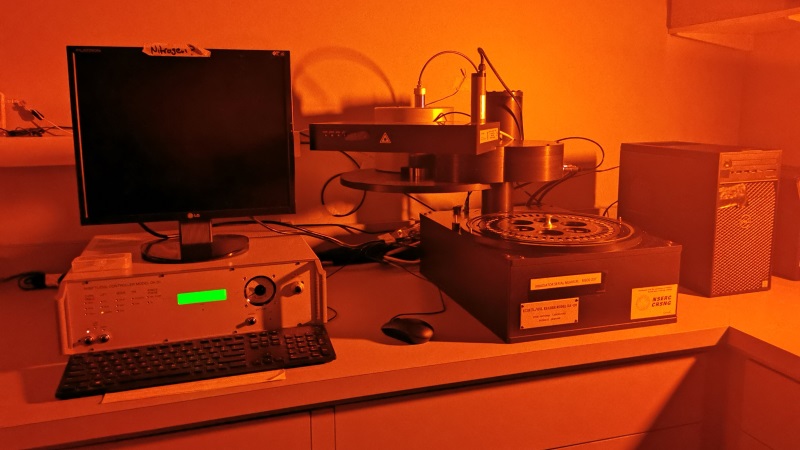Luminescence Dating Laboratory
The Luminescence Dating Laboratory in the Department of Geoscience at UFV is currently the only one of its kind in Canada west of Montreal. Construction of the lab, and the acquisition of funds to purchase equipment and supplies began in 2005 and, after delays in construction, the laboratory opened in late 2006. This was also the time in which D.J. Huntley (SFU Physics), the inventor of optical dating, retired and much of his equipment was donated to the new UFV laboratory.
The UFV Luminescence Dating Laboratory consists of two separate laboratory rooms — one is dedicated to chemical and physical preparation of sediment samples, while the other contains the instrumentation required to conduct luminescence dating experiments. Access to the luminescence dating laboratory is highly restricted and controlled.

Luminescence Dating is a technique that is used to find the time elapsed since mineral grains were last exposed to sunlight, which is usually the time at which they were buried in a landform. This allows sedimentary landforms, such as sand dunes, to be used as proxies for climate-driven landscape change.
Under the leadership of its director, Olav Lian, a former student of D.J. Huntley in the 1980s, the laboratory has grown; it has facilitated many research projects based at field sites all over the world. Most of the research is externally funded from grants from NSERC and CFI, and funds brought in from research partners, such as Natural Resources Canada, provincial geological surveys, and colleagues at other universities. Although the UFV Luminescence Dating Laboratory is a place of leading-edge research, it is also dedicated to education. As such many undergraduate and graduate students, and postdoctoral fellows have conducted their research in the laboratory (researchers) and presented it in peer-reviewed journals and at professional conferences. The laboratory continues to welcome visiting colleagues and research students.
Most of the research conducted in the UFV Luminescence Dating Laboratory is used to put long-term landscape change, as result of shifts in climate, into a secure absolute temporal context. Because luminescence dating is inherently experimental, much of our work is on adapting and testing laboratory protocols to the physical characteristics of the minerals sampled and to the sedimentary environments from which they were collected.
The UFV Luminescence Dating Laboratory does not routinely do consulting work. Instead, it is dedicated to collaboration and open dissemination of results. Its staff are involved in landform identification, sedimentology and stratigraphy interpretations, and sample site selection. All of our research is expected to be published in respectable peer-reviewed journals and made open-access whenever possible.
The UFV Luminescence Dating Laboratory is a proud sponsor of Women Geoscientists in Canada (WGC) and one of our alumni, Cassandra Shewchuk, was elected to the board of directors as secretary for WGC to help advocates for gender diversity within the geosciences.
To request more information or a visit to the facility, please contact Dr. Olav Lian.